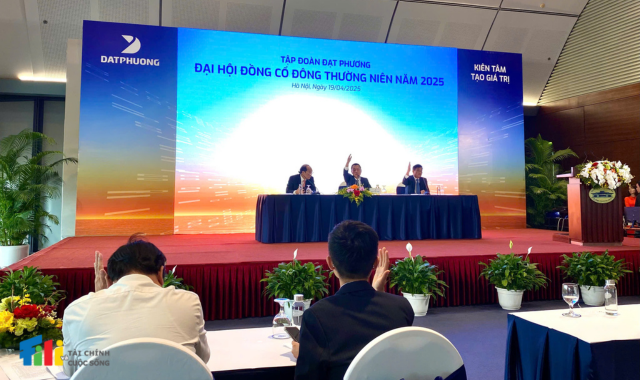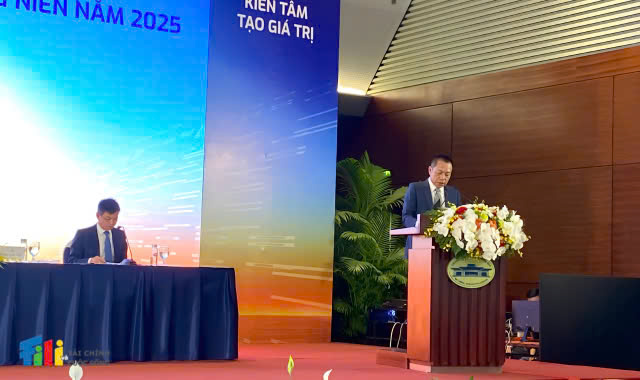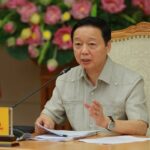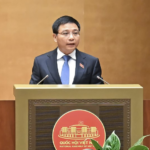Latest Updates
As of 8:56 am on April 19, 2025, the DPG Annual General Meeting of Shareholders recorded the participation of 99 shareholders, representing more than 36.5 million shares, equivalent to more than 58% of the total number of shares entitled to vote, sufficient to organize.
 DPG Annual General Meeting of Shareholders was held in the morning of April 19 in Hanoi – Photo: The Manh
|
Discussion
The ultra-white glass factory has different technology and market from Viglacera
Update on the total investment, capital structure, and progress of the ultra-white glass factory?
Chairman of the Board of Directors of Dat Phuong Luong Minh Tuan: The total investment of the glass project remains at VND 2,000 billion. The exchange rate has changed compared to before, but we have made provisions. After putting it into operation, the expected revenue is VND 1,200-1,500 billion/year. With the above investment, the payback period is about 5-6 years. It is expected that by the end of Q2/2026, the product will be put into the heating phase and start recognizing revenue.
The input material has a source of sand in Phong Dien where the factory is located. We have taken samples for testing in many countries, showing very low iron content, an important factor in the production of super white glass. Currently, we have been allowed by the province to exploit a common mine with an area of more than 3ha, enough to produce more than 15 million m2 of glass each year. In addition, the province is also proposing the Government to assign us a new mine with an area of about 169ha, enough to meet the demand for the next 30-40 years. In that area, there is also a unit, Viet Phuong, which has selected sand for sale, so the supply is very favorable.
Our technology and market are different from Viglacera. Viglacera makes super white float glass for construction, while we make super white glass for solar panels. We chose Khai Thinh Group as our partner to provide the chain. Almost the entire production chain is robotic, with human participation only in the KCS, packaging, and certain stages. The technology has a thermal radiation coefficient of about 94%, which means that with the same glass area, it can generate significantly more energy than previous generations.
Investment strategy in Dat Phuong’s ultra-white glass factory?
Chairman Luong Minh Tuan: The factory identifies the domestic market and exports mainly to Europe. The reason is that the energy demand in Europe is huge, especially after the Russia-Ukraine war. In addition, Europe is a pioneer in eliminating coal power, reducing nuclear power, and promoting clean energy. Therefore, the global market for solar glass is huge, with a high annual growth rate.
In Vietnam, Electricity Planning VIII and the policy of encouraging the installation of rooftop solar power also open up room for development. Currently, Flat Glass Company (Hong Kong, China) accounts for about 35% of the market share of glass supply for domestic solar panel manufacturers, so the potential for new manufacturers to participate in the market is clear.
In terms of products, the factory is able to customize a part or all of the capacity to produce construction glass, automotive glass. We also plan to produce patterned super white rolled glass to serve interior decoration such as hotel glass walls, as this market in Korea, Japan, and even Vietnam still has to import products.
The biggest competitor at the moment is still Chinese enterprises, accounting for about 90% of the market share of glass in general and solar glass in the world. However, we have certain advantages. First of all, in terms of raw materials: Vietnam has a stable and good quality silicate source. Meanwhile, China has to use sea sand, which takes many steps or crushes quartz stone to produce. Second, in terms of taxes: the import tax on glass from China to Europe is currently more than 9%, while from Vietnam it is only about 3%. This tax rate difference alone is a significant competitive advantage.
There is not much difference in technology between the two countries. However, Vietnam’s disadvantage is that the gas price is still higher than that of China in the past time.
The US market is not a primary target because the factory’s output compared to the European market demand is still quite small. Therefore, the US tax countermeasures are not a factor that we focus on evaluating.
Plan for investment in mining and processing of raw materials?
Chairman Luong Minh Tuan: We will invest in a sand washing plant to exploit sand as a raw material for glass, and the remainder will continue to be processed into higher value-added products such as powder used in electronics or sand for precision mechanics. This project is in the preparation phase and is expected to be approved in the second quarter of this year. If implemented smoothly, it can bring in revenue of hundreds of billions of VND each year from the processing segment. The investment form can be through member companies belonging to Dat Phuong’s ecosystem such as Dat Phuong Xuan Tra, which currently has the potential to implement expansion projects.
Impact of US-China policies on the glass segment?
Mr. Do Xuan Dien – Member of the Board of Directors and Chairman of the Audit Committee of Dat Phuong: Currently, China cannot export glass to the US, so it will turn to other markets such as Europe, where we are exporting glass. This creates competition but is also an opportunity if Dat Phuong’s products are of good quality.
If US policies go into detail and are favorable for goods produced 100% in Vietnam. Dat Phuong’s glass, which is produced entirely in Vietnam, will not be subject to taxes like Chinese goods processed in Vietnam when entering the US. If it meets the value-added ratio as required, it can take advantage of the great opportunity from the US market.
Real estate revenue will be mostly recognized in 2026-2027
In 2024, Dat Phuong Hoi An’s real estate segment lost VND 27.4 billion after tax. So, is there any basis for the plan to make a profit of VND 52.6 billion in 2025?
Chairman Luong Minh Tuan: Last year, we did not complete the revenue because we could not sell. The infrastructure has been completed, some houses have been built and fully accepted, but due to the land price appraisal procedure, we do not meet the conditions for sale, leading to no revenue and the result is a loss.
This year’s plan, we set a target to complete the land price appraisal and meet the conditions for sale in the second quarter. Currently, the initial appraisal has been basically approved, and we are speeding up the next steps. When eligible, we can sell about half of the products in the first phase. However, real estate revenue is only recognized when the house is handed over, so most of it will fall in 2026-2027. This year, a part can be recognized if it is sold and handed over in time.
Sales plan for the Casamia Balanca project and profit prospects for the period 2023-2025?
Chairman Luong Minh Tuan: The Casamia Balanca project is expected to start selling in the second quarter, with a target of selling about 50% of the volume this year. The Company has not yet approved the selling price of the adjacent and villa products.
Information about the Thang Binh project, Quang Nam province?
Chairman Luong Minh Tuan: It is expected that in May or June of this year, the necessary procedures will be completed to re-implement the project. Previously, the withdrawal of the investment policy was due to difficulties from new regulations related to the conversion of the BT (build-transfer) model, which made the investment form no longer suitable. However, the province has decided to return the project to Dat Phuong to continue implementing without having to re-bid.
Impact of administrative unit merger on DPG real estate?
Chairman Luong Minh Tuan: Regarding the merger of administrative units, it is an issue for investors to self-assess. In the real estate sector, there are many investors here who are very knowledgeable. For example, when Quang Nam merged with Da Nang, real estate went up or down, investors all understood.
Construction no longer creates windfall profits
How do you assess the prospects of the infrastructure construction sector in the coming period and Dat Phuong’s preparation to seize this opportunity?
Chairman Luong Minh Tuan: The period 2025-2030 is a very good time for the infrastructure construction sector. The current development orientation of the Government is “infrastructure goes ahead, one step of development”, so public investment in this field must be strong.
In an industry with many inherent risks like construction, maintaining efficiency and profitability is not easy, but we have done it.
What is Dat Phuong’s plan for signing new contracts and backlog in 2025? Is construction still the main force?
Chairman Luong Minh Tuan: Right in the first quarter of this year, we have bid for new projects and basically completed the plan with a value of about VND 3,000-4,000 billion. This volume is enough to implement the current work and in the rest of the year, we expect to continue to have many new projects.
Regarding backlog, in 2023, the Company recorded a record high backlog. However, there is no so-called “profit drop” fixed in a certain year. Profits are recognized according to the progress of the contract, the project is implemented to the extent that revenue is recognized. The implementation time of the current contracts is shorter than before, most of which lasts until 2023-2024, only a small part goes into 2025, unless there is a problem with the ground.
In terms of construction, there is still growth but the profit margin is not as high as before due to fierce competition in the industry. Therefore, construction no longer creates windfall profits, but only recognizes average profits, in line with the market.
Dat Phuong’s role in the North-South high-speed rail project?
Chairman Luong Minh Tuan: In terms of personnel, orientation, and approach, we have prepared early. I think the high-speed rail project is a great opportunity because the Government has a policy of prioritizing Vietnamese enterprises to participate in construction and production, except for some items that require special technology to be transferred from abroad.
What is the reason for the low profit margin in 2025 of Dat Phuong Hoi An, although revenue increased?
Chairman Luong Minh Tuan: This year’s plan of Dat Phuong Hoi An is to achieve VND 61 billion in revenue, nearly VND 60 billion in pre-tax profit, and over VND 52 billion in after-tax profit. Although the profit seems low, less than 10%, this number does not reflect the true nature.
This year’s revenue mainly comes from the recognition of house-building projects that have been implemented since previous years. Meanwhile, financial expenses, management expenses, and expenses arising from previous years’ backlog must be counted in full this year. So if 2,000-2,500 billion VND worth of products are sold, the recognized revenue is only about 600 billion VND. The profit margin has been calculated on the basis of the total operating expenses of the whole enterprise, including the portion carried forward from previous years.
 DPG Chairman spoke at the 2025 Annual General Meeting of Shareholders in Hanoi – Photo: The Manh.
|
How is the progress of the land price approval for the Con Tien project going?
Chairman Luong Minh Tuan: The People’s Committee of Quang Nam province has affirmed that it will complete the approval of land prices for the remaining phases of the Con Tien project within 12 months before the merger. Currently, we have been approved for land prices for the first two phases. The rest is being expedited to be able to keep up with the sales plan this year.
The total land use fee for the entire project area is about VND 10,000 billion. According to Decision 68 of the People’s Committee of Quang Nam province dated March 20, 2025, the land value of the first phase is VND 898 billion, with a unit price of VND 9.4 million/m2. Previously, Decision 919 dated April 10, 2024, determined the price of the first phase at VND 901 billion, with a unit price of VND 9,423 million/m2. This difference is due to legal regulations and related costs. From 2025, enterprises will be charged an additional 5.4% if they are late in paying land use fees. It is expected that the Company will have to pay an additional VND 200 billion, bringing the total to about VND 1,100 billion.
Handling situation of Binh Duong Resort Complex (Quang Nam province)?
Chairman Luong Minh Tuan: According to the proposal sent to the People’s Committee of Quang Nam province in May 2024, at the time of the withdrawal of the investment policy, the Company had poured about VND 250 billion into the project, mainly consulting and site clearance costs, which are currently recognized as inventory on the financial statements. It is expected that in May or June of this year, Dat Phuong will return to implement the Binh Duong – Doc Dua Urban Complex project as initially oriented.
Assessment of cooperation with Hilton Group in the hotel project?
Chairman Luong Minh Tuan: For domestic enterprises, self-operating hotels is very difficult, especially in terms of global marketing. Cooperation with Hilton – one of the world’s leading hotel management groups helps Dat Phuong access global resources that would not be possible if done independently.
How does the Company promote the application of technology in project operation and management?
Chairman Luong Minh Tuan: The application of technology is an inevitable trend, but it needs to be approached in a practical way, avoiding formality. We are starting with the financial sector, gradually replacing old software. The new software is developed by Dat Phuong’s technology team, with very little cost. Even the software used for voting at the General Meeting was developed internally, not purchased from outside.
At the end of the meeting, all proposals were passed.
Before the meeting
Profit plan in 2025 increased by 27%, record revenue
In 2025, Dat Phuong set a target of consolidated revenue of VND 4,755.5 billion and net profit of VND 284.4 billion, up 33% and 27% respectively compared to the performance in 2024. The plan focuses on completing the projects that are being implemented, especially in the real estate sector. The Company also expects new strides from the ultra-white glass factory project, which is expected to be completed in 2026.
In the real estate sector, Dat Phuong will continue to complete the settlement of the Vo Nghe and Dong Na urban area projects. The Con Tien project will complete the legal procedures and open for sale of 120 villas from the end of Q2/2025, with a target consumption of 50%. Casamia Hoi An Hotel will be completed and operated from 2026, while the Dong Na Hotel project is expected to start construction in the same year after signing a management contract with Hilton Group. Other projects are also being promoted in terms of procedures such as Dien Loc Industrial Cluster and the urban area south of Phu Hai Ward.
Looking back, Dat Phuong had a positive 2024, especially in the energy sector and the expansion into the ultra-white glass production sector. Specifically, consolidated net revenue reached VND 3,577.5 billion and net profit after tax was VND 223.9 billion, up 4% and 10% respectively over the previous year. Although only completing 78% of the revenue plan and 88% of the profit plan, the Company still recorded the 4th consecutive year of new revenue records.
|
Dat Phuong’s business results in |
The Legislative Assembly Passes 18 Laws and 21 Resolutions at the 8th Session
The National Assembly passed 18 laws and 21 resolutions and provided initial feedback on 10 draft laws during its 8th session.
Racing to Complete the High-Speed North-South Railway by 2045
As we delve into the developments regarding the high-speed rail project on the North-South axis, Deputy Prime Minister Tran Hong Ha emphasized the meticulous selection process for technology, management models, and operations. This meticulous process is geared towards establishing a comprehensive and autonomous railway industry and service during a meeting on the 25th of September.





































